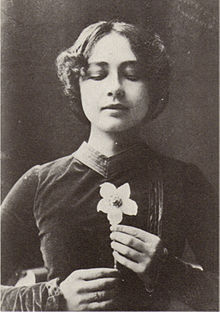To Damascus
After Damascus ( Swedish Till Damascus ) is a three-part drama by the Swedish writer August Strindberg . The first and second part appeared in 1898, the third in 1904. The first performance of the first part took place on November 19, 1900 at the Dramaten in Stockholm, the German premiere on June 9, 1916 in the Munich Kammerspiele . There, on April 10, 1956, the first German staging of the trilogy, directed by Franz Höllering , was staged .
Due to its expressionistic design language, it is considered a milestone in the development of modern drama.
action
At the beginning of the first part, the stranger , a writer who has been expelled from society for his godless writings, meets a mysterious beggar and the lady who remains his companion from now on. She leaves her husband for the sake of the stranger, but their escape together becomes a nightmare; in the end, completely impoverished, they have to flee to the lady's parents. There the lady is instigated by her mother to read the last - apparently particularly blasphemous - work of the stranger, although he had forbidden her to do so. The stranger falls madly over an abyss and is nursed to health in a monastery asylum. Under the influence of the confessor , the decisive inner change takes place - the stranger turns away from his arrogance and his bad sides. He goes through all the stations again and gets a more positive view of God and the world.
In the second part, the stranger falls back into his megalomania. He tries to produce gold and thereby destroy the world order. When he receives confirmation that he has really made gold, he leaves the lady he married and who has now given birth to a child. He lets himself be celebrated as the world's greatest scientist at a banquet by "professors" - until it finally turns out that it was the celebration of a drinking brotherhood. Mocked by the beggar and arrested by the police for not being able to pay the bill, he is completely broken. Finally he returns to the lady who asks him to go to a monastery and fundamentally change his life there.
In the last part, the stubborn stranger begins again with his inner transformation under the guidance of the confessor with the ascent to the high monastery. When he arrives at the monastery, the prior confronts him with his previous sins. The stranger begins to give up his self-pity and hatred of God. He declares himself ready to become a monk and here meets his evil spirit , who tries to dissuade him from making a decision and to reawaken his arrogance and hatred of God. The stranger overcomes him and finally dies symbolically the death of his old self.
Very strong biblical and metaphysical influences and images can be felt throughout the piece. The name of the piece is also derived from the trip of the Pharisee Saul to Damascus, on which Jesus suddenly appeared to him in a vision and then the persecutor Saul became the apostle Paul.
Even if the plot is largely based on Strindberg's personal experiences and is therefore autobiographical, the message of the piece is understood as generally human and supra-personal.
Literature-historical classification and significance
After Damascus was the first work of the Swedish writer after overcoming his inferno crisis. With this piece, Strindberg made the abrupt transition from his more naturalistic phase to an expressionistic style, which, however, also included surrealist and symbolist elements.
The Swiss theater critic Bernhard Diebold described Nach Damascus as the "mother cell of expressionist drama". In fact, Strindberg found two forms in this drama which should become typical of expressionist drama: the dissolution of the character and the station drama .
In the form of drama , sometimes also referred to as first- person drama , the characters involved, with the exception of the “first person” - in this case the unknown - do not represent real people, but symbolize the psychological aspects and characteristics of the main actor. In Nach Damascus, for example, the lady stands for the feminine principle of the soul, the lady's husband for the primordial enemy, the demon for the bad, and the beggar and confessor for the good side of the self.
In a station drama, the prototype of which To Damascus can be considered, the division into acts is abandoned and replaced by a large number of so-called stations. These symbolize the experiences of the I-person and the development and advancement of their soul. This shape is based on the passion of Christ .
Furthermore, Strindberg broke with the three Aristotelian units (unity of time, place and action), which have been more or less binding for all theater pieces since the Renaissance . Although these were no longer fully observed in earlier plays by other poets, Strindberg ignored them as consistently and consistently as few before him. The piece seems to be located “beyond time”: there are no indications of how much time elapses during the piece; whether it is months, years or decades. There are only certain indications that it could be the entire lifespan of the unknown. In the case of a total of 15 different locations in the entire piece, one can no longer speak of a unit of place. The unity of the plot is broken by the fact that the individual stations - with the exception of the first and last - would be relatively interchangeable.
Web links
Individual evidence
- ^ Eduard Höllering: Georg and Franz Höllering and the Sudeten German theaters: two biographies . Sudetendeutsches Musikinstitut, Regensburg 1998, ISBN 3-9803294-8-8 , p. 35.
- ^ Bernhard Diebold: Anarchy in Drama . Frankfurter Verlagsanstalt, Frankfurt am Main 1921, p. 173.
